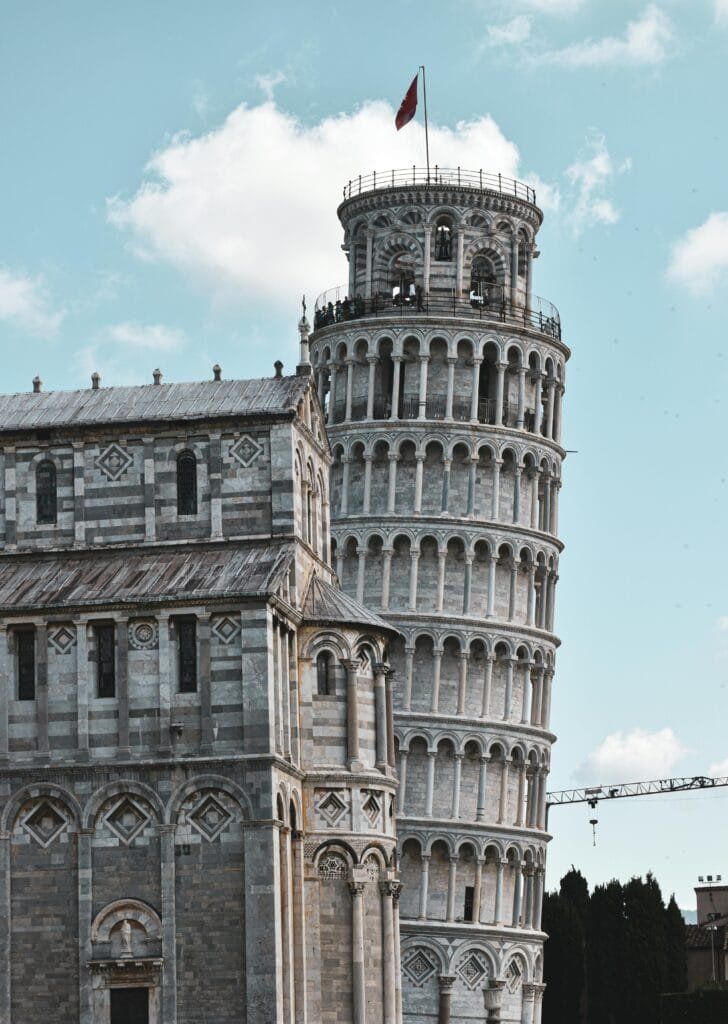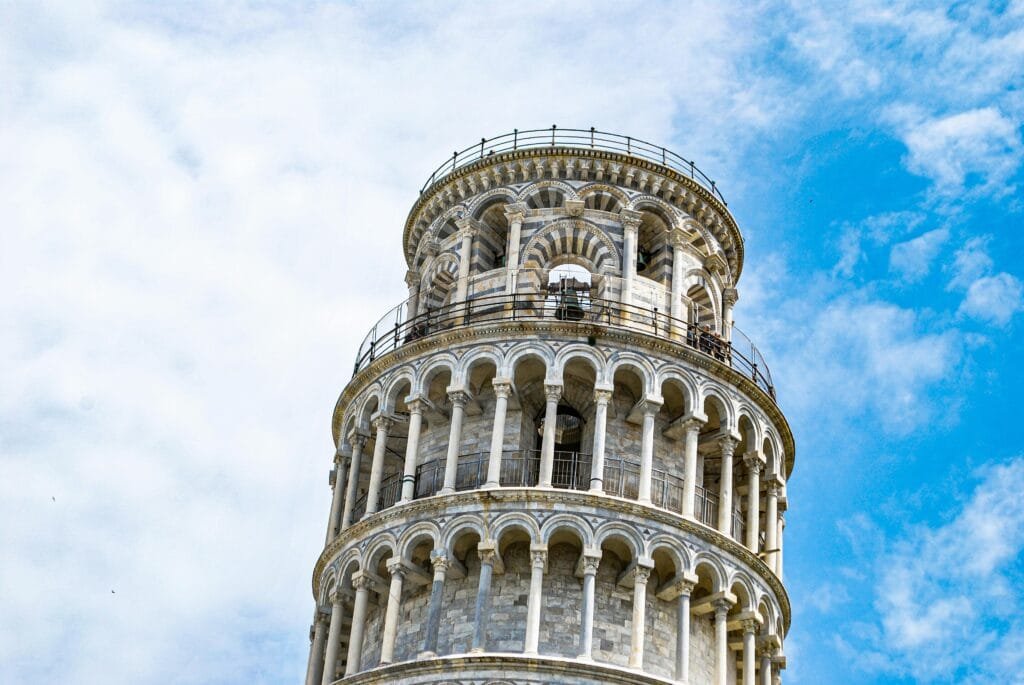Introduction

The Leaning Tower of Pisa is one of the most famous architectural wonders in the world. Known for its unintended tilt, this iconic structure attracts millions of visitors each year. Located in the Italian city of Pisa, the tower is a true testament to medieval engineering and the challenges of construction on unstable ground. But what makes this tower lean? How has it managed to survive for centuries despite its tilt? In this article, we will explore its history, construction, preservation, and interesting facts that make it a must-visit landmark.
History of the Leaning Tower of Pisa
The story of the Leaning Tower of Pisa dates back to the 12th century. It was initially designed as a bell tower for the nearby Pisa Cathedral. Construction began in 1173 during a time when Pisa was a powerful maritime republic. However, by the time the builders reached the third floor, they noticed that the structure had started to lean due to the soft ground underneath.
Despite the lean, construction continued in phases over the next two centuries. Wars and conflicts in the region often halted progress, but by 1372, the tower was finally completed. The lean became its defining feature, turning what could have been a failed project into one of the most recognizable buildings in the world.
Architectural Design and Features

The Leaning Tower of Pisa is an extraordinary example of Romanesque architecture. Built primarily from white and grey marble, the tower features intricate carvings, arched openings, and a cylindrical shape that makes it visually stunning. Standing at about 56 meters (183 feet) tall, it consists of eight stories, including the chamber that houses the bells.
Each level is surrounded by arcades, giving it a unique and elegant look. Despite its tilt, the tower remains structurally sound, a remarkable feat considering the challenges engineers faced over the centuries.
Map Location
The Leaning Effect: Why Does the Tower Tilt?
The primary reason for the tower’s lean is its weak foundation. The ground beneath Pisa consists of soft clay, sand, and silt, which could not support the weight of the structure. This uneven settling caused the tower to begin leaning while still under construction.
Over time, the tilt worsened, reaching an angle of about 5.5 degrees in the 1990s. Engineers feared that without intervention, the tower would eventually collapse. Restoration projects have since reduced the tilt to about 4 degrees, stabilizing the structure for future generations to admire.
The Construction Phases of the Tower
Building the Leaning Tower of Pisa was not a straightforward process. It took nearly 200 years to complete due to various interruptions.
- First Phase (1173-1178) – The construction of the first three floors began, but the lean became noticeable, leading to a pause.
- Second Phase (1272-1278) – After nearly a century of delay due to wars, engineers attempted to correct the lean by building upper floors at a slight angle to counterbalance it.
- Final Phase (1360-1372) – The last levels, including the bell chamber, were added, completing the tower despite its significant tilt.
The decision to continue building despite the tilt turned out to be a blessing in disguise, as the structure became a global icon.
Restoration and Preservation Efforts
Over the centuries, numerous attempts have been made to stabilize the Leaning Tower of Pisa. Early restoration efforts were limited due to a lack of advanced engineering knowledge. However, as the tilt worsened, it became clear that immediate action was necessary to prevent collapse.
In the 20th century, engineers and historians collaborated to develop solutions. Between 1993 and 2001, a major stabilization project successfully reduced the tilt by 45 cm (17 inches), bringing it back to a safer angle. The main techniques used included:
- Soil Extraction – Removing small amounts of soil from beneath the higher side helped rebalance the foundation.
- Counterweights – Lead weights were added to one side of the base to counteract the lean.
- Cable Support – Strong cables were used to temporarily hold the tower while corrective measures were implemented.
Today, experts believe the tower is stable for at least another 200 years, making it safe for visitors to enjoy.
The Leaning Tower of Pisa Today
Despite its troubled past, the Leaning Tower of Pisa remains one of Italy’s most visited tourist attractions. Visitors from around the world flock to Pisa to witness its famous tilt, take fun perspective photos, and climb to the top for a breathtaking view of the city.
Here’s what you can experience when visiting:
- Climbing the Tower – A 294-step spiral staircase leads to the top, offering stunning panoramic views.
- Piazza dei Miracoli – The tower is part of a UNESCO World Heritage Site that includes the Pisa Cathedral, Baptistery, and Camposanto Monumentale.
- Photo Opportunities – The iconic “holding up the tower” pose is a must for tourists.
The tower is a symbol of resilience and a testament to human ingenuity, standing proudly despite its original flaws.
How to Visit the Leaning Tower of Pisa
If you’re planning a visit, here’s what you need to know:
- Best Time to Visit – Early morning or late afternoon to avoid crowds.
- Ticket Prices – Entrance to the tower costs around €20, with discounts for students and children.
- Booking in Advance – Due to limited capacity, it’s best to reserve tickets online before your visit.
- Rules & Restrictions – Visitors must be at least 8 years old to climb the tower, and large bags are not allowed.
Pisa is easily accessible by train from major Italian cities like Florence and Rome, making it a great day-trip destination.
Interesting Facts About the Tower
- The tower’s tilt was discovered only after the third floor was built.
- It took nearly 200 years to complete due to frequent interruptions.
- The tower leans at an angle of about 4 degrees today, compared to 5.5 degrees before restoration.
- There are seven bells inside the tower, each tuned to a musical note.
- The lean was unintentionally created but became its most famous feature.
Myths and Legends of the Tower
Like any iconic structure, the Leaning Tower of Pisa has inspired myths and legends. Some of the most popular stories include:
- The Cursed Ground – Some locals believe that the unstable ground beneath the tower was cursed, causing it to lean.
- A Secret Underground Chamber – Rumors suggest that a hidden chamber beneath the tower contains treasures from Pisa’s past.
- A Deliberate Lean – A popular but false theory is that the tilt was intentionally designed to attract tourists.
Though these myths add to its mystery, the real reason for the lean remains its soft foundation.
Connection with Galileo Galilei
One of the most famous stories linked to the Leaning Tower of Pisa is Galileo Galilei’s gravity experiment. According to legend, the renowned scientist dropped two spheres of different masses from the top of the tower to prove that objects fall at the same rate regardless of weight.
Though there is no concrete evidence that this experiment actually took place, the story has become a fundamental part of physics education worldwide.
Comparison with Other Leaning Towers in the World
While Pisa’s tower is the most famous, it’s not the only leaning tower in the world. Here are a few others:
- The Leaning Tower of Suurhusen (Germany) – Tilts more than Pisa’s tower.
- The Leaning Tower of Nevyansk (Russia) – Built with a deliberate tilt.
- The Leaning Tower of Bologna (Italy) – Another Italian marvel with an unexpected tilt.
Despite many similar structures, none have gained the global recognition that Pisa’s tower enjoys.
Leaning Tower of Pisa in Popular Culture
The Leaning Tower of Pisa has been featured in various forms of media, including:
- Movies – Appears in films like Superman III and The Lizzie McGuire Movie.
- Cartoons – Frequently referenced in Looney Tunes and The Simpsons.
- Logos and Advertisements – Used as a symbol of Italy in travel ads and promotional campaigns.
Its iconic image continues to inspire artists, filmmakers, and storytellers worldwide.
Future of the Leaning Tower of Pisa
Though recent restoration efforts have stabilized the tower, its future remains uncertain. Engineers predict that further corrections might be needed in the coming centuries to keep it standing. Possible future projects include:
- Additional soil reinforcement to further reduce the tilt.
- Advanced monitoring systems to detect early signs of instability.
- New preservation techniques to prevent erosion of the marble.
Despite the challenges, Pisa’s famous landmark will likely continue to attract visitors for generations to come.
Conclusion
The Leaning Tower of Pisa is more than just a tilted structure—it’s a symbol of architectural resilience, human ingenuity, and historical legacy. From its accidental lean to its worldwide fame, the tower continues to captivate tourists, historians, and engineers alike. Whether you visit for its breathtaking views, historical significance, or fun photo opportunities, the Leaning Tower of Pisa remains one of the most fascinating landmarks in the world.
FAQs
1. Why does the Leaning Tower of Pisa lean?
The tower leans due to a weak foundation on soft soil, causing it to tilt during construction.
2. Can visitors climb the Leaning Tower of Pisa?
Yes! Visitors can climb 294 steps to the top, but there are age and health restrictions.
3. How was the tower stabilized?
Engineers used soil extraction, counterweights, and cable supports to reduce the tilt and prevent collapse.
4. Is the Leaning Tower of Pisa safe to visit?
Yes, after extensive restoration, the tower is now stable and safe for tourists.
5. What is inside the Leaning Tower of Pisa?
Inside, you’ll find a spiral staircase leading to the top, as well as chambers that once housed bells.
For more detailed information, please visit the official website of the Opera della Primaziale Pisana

